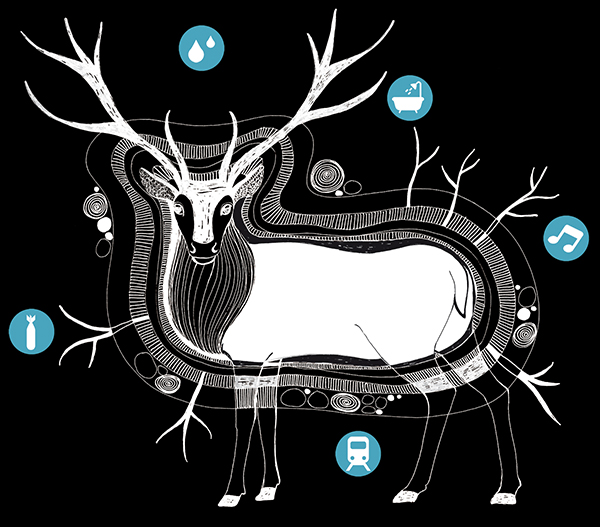When Milan had no beginning
When Milan had no end
When Milan slipped into the water
Into the sound of water
Into the silence
Aldo Nove, Milano non è Milano
The water under the city
Milan, unlike other Italian and European cities, doesn’t have a large river linked to its name. In its history there is no Tiber or Seine; rather, Milan was and still is crossed by a network of small streams and channels.
The relationship of the Lombard capital to water, however, has often been controversial. Beginning in the second half of the nineteenth century, and then to a greater extent in the 1930’s, the Milanese rivers and channels were almost completely covered. The channels, because of the difficult conditions through which they flowed, had become a public health concern and were also considered an obstacle in the path of urban development and the construction of new roads.
And thus water has become a predominantly subterranean affair.
the Sewer system
Among the conduits that run more than 1400 km below the city’s surface are those belonging to the sewer system, built in the late nineteenth century, and gradually enlarged and improved over the years.
The changes - necessary first of all owing to the territorial and demographic expansion of the city - have, however, never altered the two basic features of the Milan sewer system.
The system has in fact always been characterized by a unified management of sewage and runoff. It has also exploited the lay of the land, which has allowed the construction of conduits that use the force of gravity to guide the flow of the water.
Sewer structures
There are some strategic points in the system, real hydraulic nodes where the main sewers converge.
Among the most significant structures are those of piazza Bonomelli, Ponzio-Bonardi and via Pacini.
the Structure in piazza Bonomelli
This occupies the entire square, which appears in the video at the beginning of this route. Here the two branches of the Nosedo sewer and the "outlet" conduit flow into the Cavo Redefossi, which receives the overflow from the two branches when there are heavy rains.
Construction began in 1900, and ended in 1927.
the Structure in via Pacini
Built between 1925 and 1927, it is located a few hundred meters from the structure at Ponzio-Bonardi, with which it shares a circular design.
Five conduits converge at this place, four of them originating from via Pacini and one from via Teodosio.
the Structure at Ponzio-Bonardi
This structure receives the water from "Ampliamento Est" as well as from the conduits originating from Bonardi and Ponzio streets. Constructed between 1925 and 1926, it is circular and is covered by a recessed dome.
Water outside the city
The primary destination of sewage and stormwater has long been the Roggia Vettabia, a conduit that connected the city's sewer system to the agricultural area which developed south of Milan.
The main waste disposal system was conceived to put the sewage to use in the water-meadows, a method introduced by the Cistercian monks of Clairvaux in 1200 for the production of forage. This system of purification remained viable until the advent of industrialization in the twentieth century, when the proliferation of factories as well as population growth rendered it ineffective.
In 2001, following the implementation of a European Community directive, construction was begun on three sewage treatment plants – Milano Nosedo, Milano San Rocco and Peschiera Borromeo – each of which began functioning between 2003 and 2005.
the Nosedo purification plant
This one serves the east-central area of the city of Milan and has a processing capacity to provide for a population of about 1,250,000 inhabitants.
It returns treated sewage to the system south of Milan, where it is used mainly for agricultural and irrigation purposes.
The first phase of the purification treatment is mechanical: the coarser components of the effluent are eliminated by means of a system of presses.
In the second phase the sewage passes through tanks in which the action of various bacteria degrades the biological content and eliminates substances such as nitrogen and phosphorus.
Navigation Info
On your journey you can control the playback of audio and video files with the menu navigation buttons located at the top of each page of Sotterranea.
Pausa / Play: both the video and the audio will start and stop based on the positioning of the page. You can also pause a video by clicking on the play area; clicking it again will resume play.
Volume: click on the buttons to raise and lower the volume.
Full screen: this button enables viewing in full screen.
Buffering: this button controls the percentage of the video buffered .
Video quality: the videos play in standard definition (SD); to access versions in high definition, click on the HD button.
And that’s the end of this route [info on the contents],
choose another route to explore!
Water - Info on the contents of this route
The quote from Aldo Nove is taken from Il poema di Milano. I Navigli", poetry from the book Milano non è Milano published by Laterza Publishing House in 2004.
The video shoot took place at the sewer structures in Milan’s Bonomelli Square, Pacini and Ponzio-Bonardi streets, and at the Nosedo purification plant.
The environmental sound was recorded in Bonomelli square and at the Nosedo purification plant.

explore the Water,